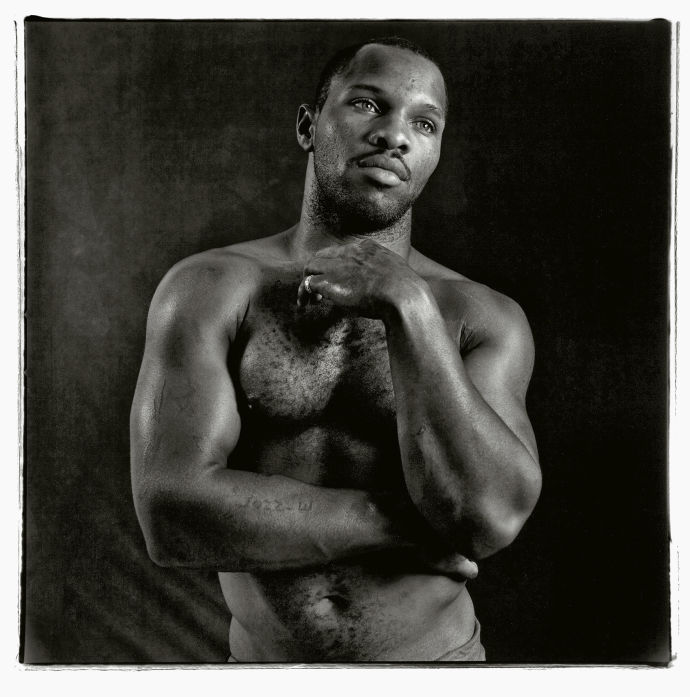by Hilton Als, via newyorker.com

Ricky Garner, 1989
I don’t know why I assumed that the late George Dureau died of AIDS. Probably because he photographed the male body in the nineteen-seventies and eighties, and I just assumed that if the focus of your art was men back then you died—that your interest was fatal. This is not an unreasonable knee-jerk reaction; it’s a measure of how deep the death scars live in me, still, based on all those days, weeks, and years spent with people who were always leaving, riddled by Kaposi’s sarcoma and fear and government neglect.
Dureau in fact died from the effects of Alzheimer’s, in 2014, in his home town of New Orleans; he was eighty-three years old. I learned these and other facts from Philip Gefter’s excellent introduction to Aperture’s “George Dureau: The Photographs,” which, it turns out, is only the second volume of the artist’s work to be published; the first was his legendary “George Dureau/New Orleans,” which came out in 1986. I think that must have been the first time I saw Dureau’s work, and once I did I felt it was “everywhere,” or placed side by side with Robert Mapplethorpe’s, which was, by 1986, ubiquitous, and disturbing in a way that was different from Dureau’s disturbing pictures. (The two were friends and competitors; Mapplethorpe first learned of George Dureau’s work through the legendary photography collector Sam Wagstaff, who was Mapplethorpe’s lover.)
While Mapplethorpe recorded his idea of perfection, or the perfect picture, Dureau made a record of his own kind of Greco-Roman classicism, a museum-quiet world filled with Apollos without arms and legs, sometimes, but always astonishing torsos and heads. That many of these broken statues are men of color can be disturbing, and I’m not sure of Dureau’s motives when it came to casting, except that he was a white artist living in the South, and in a city that is profound in its relationship to blackness, and perhaps he wanted to explore that story for himself. Since Dureau was not, on any level, “like” his subjects—he was white, and his body was whole—he may have been struck by the physical dissimilarities, which are always a draw for photographers: part of their job is to explore the world outside the self as it reflects the self.
Dureau began taking pictures in the nineteen-sixties, with a Hasselblad. He did not think of photography as a “total” artistic medium, the way drawing and painting were, but his photographs are his best work, maybe because it’s the work he cared less about. His drawings and paintings are romantic in a different way; they are too suffused with his sensibility, or self-regard. The camera gave him a certain distance, and the pictures a moral ambiguity or weight that’s missing in his other work: one feels, in looking at his paintings and so on, that one is in the presence of a man who missed the days when monkeys were trained to peel fruit on command, and blackamoors were scattered across marble floors. As Gefter points out, Dureau’s behavior could verge on the grand, but I think that’s the defensiveness most artists have when they live in small towns: they know their world is limited.
So Dureau made his own kingdom. His studio was peopled with the folks he photographed, and sometimes I’m happy they let themselves be recorded—who else would remember them? But other times I want to look away. Why were they delighted for Dureau to memoralize them? We’ll never know. Pictures are a silent medium. The best of Dureau’s photographs, which are shot in square-format black-and-white, do not have human “strangeness” at their center; they are about the artist’s curiosity, and not about treating others as curiosities. The portraits I’m thinking of, such as “Christopher Fisher” and “Craig Scott,” are records of male beauty—and self-regard.
Dureau’s 1985 portrait of Robert Mapplethorpe shows us something else, something creepy: Mapplethorpe as the voyeur who’s very interested in himself. I think Dureau was self-interested in a different way. Unlike Mapplethorpe, who was interested in power—sexual, financial, and so on—Dureau had a distinctly New Orleanian relationship to life. Sometimes, in looking at his work, I think back to another New Orleans native: Truman Capote, who wrote, in his beautiful 1946 essay, of how he didn’t like the “old charm” view of the city; there was a lot of loneliness and violence there. I think Dureau’s subjects are spiritually lonely, and what they longed for, even more than the artist, was a moment of connection that life had denied them.
